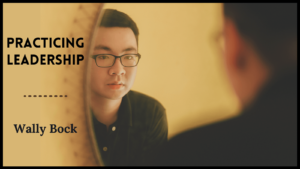 First, we said, “Practice makes perfect.” Then, we heard about Anders Ericsson and “deliberate practice.”
First, we said, “Practice makes perfect.” Then, we heard about Anders Ericsson and “deliberate practice.”
It turned out that deliberate practice was only good for certain fields. For deliberate practice to work you needed a recognized body of knowledge. You needed standard training methods. And you needed coaches who could deliver it. In his book, Peak, Ericsson introduced the idea of “purposeful practice.”
Purposeful practice is for all those fields not like playing the violin or ballet. With purposeful practice, you had practice sessions with a goal. You practiced. Then, you critiqued your performance.
But that’s still a problem for leaders. Cooks can practice by testing out different recipes. They can practice by trying their skills and assessing results. Leaders can’t do that.
The Practice Problem for Leaders
You learn some things from experience and reflection. In many fields, you can also have real practice, like a dancer or like a cook. But leaders can’t practice on team members.
We need a way to develop our skills besides learning from experience. Roleplaying won’t really do the job. It’s hard to arrange. And because there’s no real possibility of loss, there’s not much emotion in a roleplay. The best roleplays require professional actors.
What’s left is adapting purposeful practice to the special situation of leadership.
Mental Rehearsal
Mental rehearsal is one way to adapt purposeful practice to leadership. The top-performing supervisors I studied all did this.
Most of them kept up a constant game of “What if?” throughout the day. They thought about things that might happen and how they ought to respond. That’s a good practice for you.
Another way to engage in purposeful practice is to develop scenarios and imagine how you would respond to them. This is like the realistic training that the military has learned to provide.
Navy Captain Frank Ault wrote the report that resulted in “Top Gun.” He defined “The 10 Mission Rule.” Once a naval aviator had engaged in 10 missions, the odds went way up the aviator would survive his tour. Practice should simulate the actual experience, so you learn to recognize what’s happening and respond quickly and surely.
Set up mental training to increase your odds of success. Imagine situations you’re likely to face as a leader. Make a list of situations you’ve observed. Try different ways of dealing with them. You’ll develop the situational awareness that will help you in your day-to-day work.
Warmup Exercises
Musicians, dancers, and athletes all have warm-up exercises. Those exercises are specific routines they follow before they perform. You can do the same thing.
All the great supervisors I studied developed some version of this. Each one was different.
Most of the supervisors reviewed the issue were going to face and what they wanted to achieve. That’s helpful because it gets the relevant facts in your head. Try reviewing the situation by telling yourself the story of the situation.
Several of the top supervisors did some unrelated warm-up. Some of them read something helpful or inspiring. Others meditated or prayed.
Learn While Doing
I didn’t say learn by doing. I’m talking about learning while you’re performing.
Learn to concentrate on your performance and critique it at the same time. Performers of all kinds do this routinely. A good speaker notices the audience reaction, reaches for a bit of schtick to fill a gap, and adjusts on the fly. You can do that, too.
Consolidate Your Learning
Learn from purposeful practice the way you learn from experience. That starts with taking contemporaneous notes.
Jot down how things went and what you learned. Do it soon. The longer you wait, the less accurate your notes will be.
Reflect on what you’ve learned and what you’d like to practice next. A development journal is a great place to collect all your learning. That makes it easier to spot patterns.
Takeaways
You can’t practice leadership like you practice the violin or cooking.
Play “What if?”
Rehearse mentally for possible and planned situations.
Develop warm-up exercises.
Learn to observe your performance in the moment.
Take contemporaneous notes on your performance.
Consolidate your learning with review and reflection.


There are no comments yet, why not be the first to leave a comment?